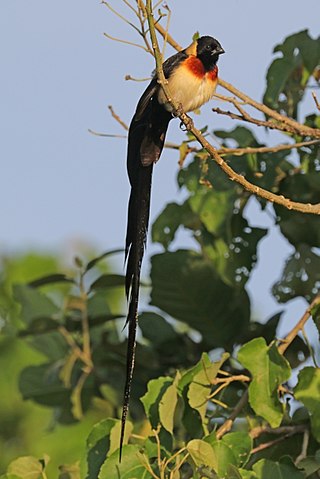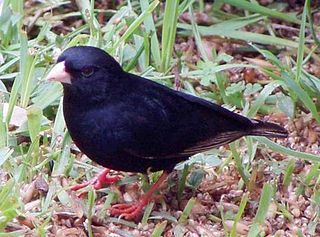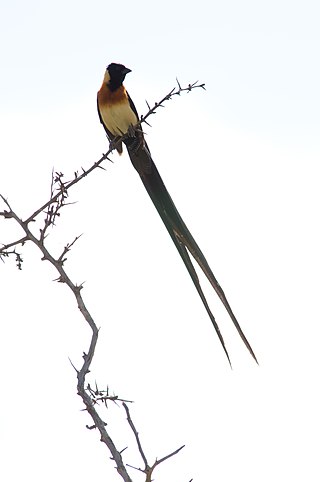Related Research Articles

The pin-tailed whydah is a small songbird with a conspicuous pennant-like tail in breeding males. It is a resident breeding bird in most of Africa south of the Sahara Desert.

The long-tailed paradise whydah or eastern paradise whydah is from the family Viduidae of the order Passeriformes. They are small passerines with short, stubby bills found across Sub-Saharan Africa. They are mostly granivorous and feed on seeds that have ripen and fall on the ground. The ability to distinguish between males and females is quite difficult unless it is breeding season. During this time, the males molt into breeding plumage where they have one distinctive feature which is their long tail. It can grow up to three times longer than its own body or even more. Usually, the whydahs look like ordinary sparrows with short tails during the non-breeding season. In addition, hybridization can occur with these paradise whydahs. Males are able to mimic songs where females can use that to discover their mate. However, there are some cases where females don't use songs to choose their mate but they use either male characteristics like plumages or they can have a shortage of options with song mimicry. Paradise whydahs are brood parasites. They won't destroy the eggs that are originally there but will lay their own eggs in other songbirds nest. Overall, these whydahs are considered least concerned based on the IUCN Red List of threatened species.

The shaft-tailed whydah or queen whydah is a small, sparrow-like bird in the genus Vidua. During the breeding season the male has black crown and upper body plumage, golden breast and four elongated black tail shaft feathers with expanded tips. After the breeding season is over, the male sheds its long tail and grows olive brown female-like plumage.

The white-collared monarch is a species of bird in the family Monarchidae. It is found in the Solomon Islands of Ugi and Makira.
The Zambezi indigobird, also known as the twinspot indigobird or green indigobird, is a species of bird in the family Viduidae. It is found in Malawi, Tanzania, Zambia, and Zimbabwe.

The straw-tailed whydah is a species of bird in the family Viduidae. It is found in Ethiopia, Kenya, Somalia, South Sudan, Tanzania, and Uganda. Its natural habitat is dry savanna. Like all other whydah species, the straw-tailed whydah is a brood parasite.

The dusky indigobird, variable indigobird, or black widowfinch is a species of bird in the family Viduidae. It is found in Angola, Burundi, Cameroon, Republic of the Congo, Democratic Republic of the Congo, Eswatini, Guinea-Bissau, Malawi, Mozambique, Nigeria, Sierra Leone, South Africa, Tanzania, Zambia, and Zimbabwe. Its natural habitat is moist savanna.

The exclamatory paradise whydah or Uelle paradise whydah is a species of bird in the family Viduidae. It is also known as the long-tailed paradise whydah, a name which may also refer to the related species Vidua paradisaea.
The barka indigobird is a species of bird in the family Viduidae. It is found in Cameroon, Ethiopia, Gambia, Ghana, Guinea, Nigeria, Sudan, and South Sudan. It is also known as the baka indigobird but the spelling "barka" is more correct; the word is a greeting in the Hausa language.

The broad-tailed paradise whydah is a species of bird in the family Viduidae. It is found in woodland and acacia savanna habitat in Sub-Saharan Africa from Angola to Uganda, Tanzania and Mozambique. A brood parasite, it has a wide range and the International Union for Conservation of Nature has assessed it as being of least concern.

The purple indigobird is a species of bird in the family Viduidae. It is also known as the dusky indigobird, a name which can refer to Vidua funerea. It is found in Angola, Botswana, Democratic Republic of the Congo, Kenya, Malawi, Mozambique, South Africa, Tanzania, Zambia, and Zimbabwe. Its natural habitat is dry savanna.
The jambandu indigobird is a species of bird in the family Viduidae. It is also known as the goldbreast indigobird. It is found in Benin, Burkina Faso, Cameroon, Central African Republic, Ghana, Guinea, Ivory Coast, Liberia, Nigeria, Sierra Leone, South Sudan and Togo. Its habitat is savannah and brush.
Wilson's indigobird or the pale-winged indigobird, is a species of bird in the family Viduidae. It is found in Cameroon, Central African Republic, Chad, Republic of the Congo, Democratic Republic of the Congo, Ivory Coast, Ghana, Guinea, Guinea-Bissau, Nigeria, Senegal, South Sudan, and Togo.
The Cameroon indigobird is a species of bird in the family Viduidae. It is considered by some authors to be a subspecies of the variable indigobird. They range from Sierra Leone to east Cameroon, north east Zaire and South Sudan.
The quailfinch indigobird is a small songbird. It is a resident breeding bird in The Gambia, Nigeria and Cameroon. It occurs in isolated localities, especially on river flood plains.

The Sahel paradise whydah, yellow-naped whydah or northern paradise whydah is a small songbird.
Catocala vidua, the widow underwing, is a moth of the family Erebidae. The species was first described by James Edward Smith in 1797. It is found in North America from southern Ontario, into Maine, New Hampshire and Connecticut, south at least to Tennessee, Georgia and Alabama, west to Texas and Oklahoma, and north to Wisconsin.
Amerila vidua is a moth of the subfamily Arctiinae. It was described by Pieter Cramer in 1780. It is found in Cameroon, Democratic Republic of the Congo, Equatorial Guinea, Ethiopia, Ghana, Guinea, Ivory Coast, Kenya, Mauritius, Nigeria, Sierra Leone and Tanzania.

Colobotheini is a tribe of longhorn beetles of the subfamily Lamiinae.

Colobothea is a genus of longhorn beetles of the subfamily Lamiinae.
References
- ↑ BioLib.cz - Colobothea vidua. Retrieved on 8 September 2014.